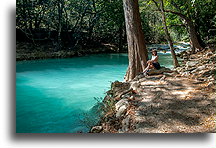Another ruins where we were not allowed to visit
March 19



We spent the night in the parking lot of Centro Ecoturistico Chinkultic located close to the Guatemala border. The hotel was completely deserted, absolutely no guests, just one security guard. When we showed up there late in the evening yesterday, he was surprised that someone had come, but for 50 pesos he let us stay overnight. In the morning, we realized we had a beautiful view of the Maya temple on the hill in front of us. During our entire World of the Maya expedition, there was not often an opportunity to camp with a view of the ruins. Before visiting the ruins, we drove through the nearby farmlands. While enjoying the idyllic views, we noticed several rocky mounds between the fields, which could be the remnants of ancient Maya structures.





While visiting this archaeological site, we found out that it was one of the largest Maya cities in the Laguans de Montebello region. Strategically located near lakes and a large cenote, Chinkultic considered is the gateway to the Guatemalan Highlands. The city was inhabited from 100 BC to AD 700. It flourished at the end of the Maya Classic Era and shared the global decline of many Maya cities at the end of this period. However, the memory of this city did not fade away quickly. For the next several centuries, Chinkultic served as a necropolis for people living in the surrounding area.



This place receives very limited number of visitors. While there, we had the ruins to ourselves. The most interesting is the main Acropolis #1 atop of the hill with breathtaking view of the cenote below. An interesting fact is that some artifacts were recovered from the bottom of this turquoise cenote. Several stone stelae depicting local rulers have also been discovered in Chinkultic. Many structures here are still overgrown, awaiting further archaeological research.
From Chinkultic we headed to nearby Tenam Puente, another Maya archaeological site in Chiapas. From the main road, we followed the signs to the ruins. On the outskirts of the village of Francisco Sarabia we came across a barrier. At least a dozen man were hanging there. One of them waved for us to stop. I thought we would have to pay toll to the local community. A man, apparently a senior in this group, asked us about the purpose of the visit. I told him we wanted to see the ruins. "You can't go there, the ruins are closed," he replied. It was extremely surprising for me. Archaeological sites are under control of the federal institution, not the local community. Arguing with him was risky though, so I politely asked if I could take a picture with the barrier closed. Unfortunately, he did not let me do that either. Having no other choice, we turned back. We realized that these were the second Maya ruins, both in Chiapas that locals did not allowed us to visit. The previous incident at Bonampak was more drastic.





From there, we went directly to Cascada El Chiflón where we planned to spend the night. The local community maintains the park around the creek. Before diner, we still had time to admire the beauty of nature. Along the trail, we watched several smaller, easily accessible waterfalls with turquoise-colored cascades until we reached the main, massive white veil of falling water. This place is worth to visit.













